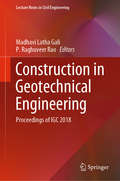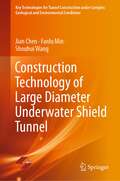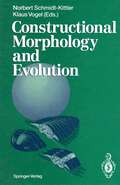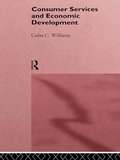- Table View
- List View
Construction in Geotechnical Engineering: Proceedings of IGC 2018 (Lecture Notes in Civil Engineering #84)
by Madhavi Latha Gali P. Raghuveer RaoThis volume comprises select papers presented during the Indian Geotechnical Conference 2018. This volume discusses construction challenges and issues in geotechnical engineering. The contents cover foundation design and analysis, issues related to geotechnical structures, including dams, retaining walls, embankments and pavements, and rock mechanics and construction in rocks and rocky environments. Many of the papers discuss live case studies related to important geotechnical engineering projects worldwide, providing useful insights into the realistic designs and constructions. This volume will be of interest to students, researchers and practitioners alike.
Construction Materials: Geology, Production and Applications (Springer Textbooks in Earth Sciences, Geography and Environment)
by Manuel Bustillo RevueltaConstruction Materials is a comprehensive textbook covering all raw materials and products related to the construction processes, and not only those applied to building structures. The book is organized to help readers achieve competent knowledge about construction materials. At the beginning of the book the author offers the general concepts, definitions, and standards adopted worldwide for these materials to be used along the book. The central part of the text covers the primary construction materials required to manufacture concrete and mortars, the most relevant construction materials in the last century. Expressly, concrete and mortar are treated in detail in dedicated chapters per component. In addition, the author addresses other relevant materials in construction such as ceramic materials, metals and alloys, bituminous materials, and geosynthetic materials. Finally, since the construction industry is one of the largest single waste producing sector in the world, the last chapter outlines the main types and characteristics of construction and demolition waste (e.g. recycled aggregates).The book appeals to students but also professionals interested in construction materials and construction and civil engineering.
Construction of Buildings on Expansive Soils
by E.A. SorochanThe series comprises selected translations of Russian geotechnical literature, and this is a translation of a 1989 second edition reference. Coverage includes laws governing expansion and contraction of argillaceous soils, principles governing deformation of soil mass and foundations during soil exp
Construction of Buildings on Expansive Soils
by E.A. SorochanThe series comprises selected translations of Russian geotechnical literature, and this is a translation of a 1989 second edition reference. Coverage includes laws governing expansion and contraction of argillaceous soils, principles governing deformation of soil mass and foundations during soil exp
Construction of Mappings for Hamiltonian Systems and Their Applications (Lecture Notes in Physics #691)
by Sadrilla S. AbdullaevBased on the method of canonical transformation of variables and the classical perturbation theory, this innovative book treats the systematic theory of symplectic mappings for Hamiltonian systems and its application to the study of the dynamics and chaos of various physical problems described by Hamiltonian systems. It develops a new, mathematically-rigorous method to construct symplectic mappings which replaces the dynamics of continuous Hamiltonian systems by the discrete ones. Applications of the mapping methods encompass the chaos theory in non-twist and non-smooth dynamical systems, the structure and chaotic transport in the stochastic layer, the magnetic field lines in magnetically confinement devices of plasmas, ray dynamics in waveguides, etc. The book is intended for postgraduate students and researches, physicists and astronomers working in the areas of plasma physics, hydrodynamics, celestial mechanics, dynamical astronomy, and accelerator physics. It should also be useful for applied mathematicians involved in analytical and numerical studies of dynamical systems.
Construction of the Façade Systems: Production and Assembly Procedures of the Advanced Building Envelopes (SpringerBriefs in Applied Sciences and Technology)
by Ingrid Paoletti Massimiliano NastriThe book explores the advanced façade systems according to the productive and constructive contents, in a cognitive and operative form, as a manual text to provide guidelines for researchers, technicians and professionals. It provides operational guidance for the technological design, production planning and site executive coordination for the realization of façade systems. The analysis deals with the main building elements and technical interfaces. The study of the façade systems, after explaining the anchoring structures and their connections to the load-bearing elements, investigates the criteria for the assembly between the framings. In particular, the book examines the technical interfaces of the main advanced envelope systems with respect to the functional, constructive and applicative coordination procedures of the mullions and transoms framing, of the structural sealant glazing façade system, of the unit façade system, of the suspended façade system and of the double skin façade system. The technical and manual character of the book is also expressed through the analysis of the functional and application procedures of the gaskets with respect to the façade systems in order to prevent the transmission of air and water loads: the analysis focuses on the connections between the framing and the enclosure elements of the envelope, in accordance with the compensation of height differences in order to guarantee impermeability, airtightness and insulation. Then, the book describes the assembly and interface conditions between elements of different composition and production within the façade systems: the examination of the technical interfaces involves the development and application of sealants, based on the loads exerted on the jointing devices, in order to fulfill the requirements of sealing and tightness with respect to mechanical, thermal and hygrometric, water, air and wind stresses. Moreover, the study of the envelope systems examines the methodologies directed toward fulfilling the requirements with respect to the actions caused by fire loads, considering the contents related to both components and connections and fixing surfaces.
Construction Technology of Large Diameter Underwater Shield Tunnel (Key Technologies for Tunnel Construction under Complex Geological and Environmental Conditions)
by Jian Chen Fanlu Min Shouhui WangThis book systematically introduces the new technology used in the construction of underwater large slurry shields under complex conditions. The basic principles, scope of application, construction technology and technical points of the key technologies such as the origin and arrival of the shield, crossing the shallow soil in the middle of the river, crossing the guard, and changing the knife and opening the knife are clarified.
Constructional Morphology and Evolution
by H. SchäferConstructional morphology explains features of organisms from a constructional and functional point of view. By means of physical analysis it explains the operational aspects of organic structures - how they can perform the activities organisms are expected to fulfil in order to survive in their environment. Constructional morphology also explains options and constraints during the evolution determined by internal constructional needs, ontogenetic demands, inherited organizational preconditions and environmental clues.
Constructive and Destructive Waves (large print)
by RnibThis page shows two cross sectional images of beaches and waves, one on the top and one on the bottom of the page. The images are surrounded by an image border. There is a small key at the top of the page. There is a locator dot shown, which will be at the top left of the page when the image is the correct way up. The image on the top of the page shows small constructive waves. The beach has a gentle slope rising from the left to the beach on the right. This allows a strong swash that can deposit sand on the beach. The gentle, shallow profile means the backwash is weak and little material is taken back to the seabed. The image on the bottom of the page shows destructive waves. The beach has a steep slope rising from the left to the beach on the right. This means the swash is short and weak. The steep profile means the waves are big with most of the energy from the waves crashing down vertically onto the beach eroding it. The steep profile generates a strong backwash which drags material back to the seabed.
Constructive and Destructive Waves (UEB contracted)
by RnibThis page shows two cross sectional images of beaches and waves, one on the top and one on the bottom of the page. The images are surrounded by an image border. There is a small key at the top of the page. There is a locator dot shown, which will be at the top left of the page when the image is the correct way up. The image on the top of the page shows small constructive waves. The beach has a gentle slope rising from the left to the beach on the right. This allows a strong swash that can deposit sand on the beach. The gentle, shallow profile means the backwash is weak and little material is taken back to the seabed. The image on the bottom of the page shows destructive waves. The beach has a steep slope rising from the left to the beach on the right. This means the swash is short and weak. The steep profile means the waves are big with most of the energy from the waves crashing down vertically onto the beach eroding it. The steep profile generates a strong backwash which drags material back to the seabed.
Constructive and Destructive Waves (UEB uncontracted)
by RnibThis page shows two cross sectional images of beaches and waves, one on the top and one on the bottom of the page. The images are surrounded by an image border. There is a small key at the top of the page. There is a locator dot shown, which will be at the top left of the page when the image is the correct way up. The image on the top of the page shows small constructive waves. The beach has a gentle slope rising from the left to the beach on the right. This allows a strong swash that can deposit sand on the beach. The gentle, shallow profile means the backwash is weak and little material is taken back to the seabed. The image on the bottom of the page shows destructive waves. The beach has a steep slope rising from the left to the beach on the right. This means the swash is short and weak. The steep profile means the waves are big with most of the energy from the waves crashing down vertically onto the beach eroding it. The steep profile generates a strong backwash which drags material back to the seabed.
Constructive Margin (large print)
by RnibThis diagram shows a vertical cross section of a constructive margin: the catastrophic parting of two oceanic or two continental plates. There is a locator dot shown, which will be at the top left of the page when the image is the right way up. Each object has a descriptive label. The diagram is framed by a dashed line image border. The bottom of the page is occupied by a section of the earth's mantle, which consists of hot rock. At the centre of the page are two plates moving away from each other horizontally towards the left and right of the page. The directions of movement are shown by arrows on each plate. The rock of the mantle melts, and this molten lava flows through the central space left by the parting plates. Further up the page the lava meets the sea. Here it is cooled by the water where it solidifies and forms an underwater volcano. At the top of the page is the atmosphere above the sea.
Constructive Margin (tactile)
by RnibThis diagram shows a vertical cross section of a constructive margin: the catastrophic parting of two oceanic or two continental plates. There is a locator dot shown, which will be at the top left of the page when the image is the right way up. Each object has a descriptive label. The diagram is framed by a dashed line image border. The bottom of the page is occupied by a section of the earth's mantle, which consists of hot rock. At the centre of the page are two plates moving away from each other horizontally towards the left and right of the page. The directions of movement are shown by arrows on each plate. The rock of the mantle melts, and this molten lava flows through the central space left by the parting plates. Further up the page the lava meets the sea. Here it is cooled by the water where it solidifies and forms an underwater volcano. At the top of the page is the atmosphere above the sea.
Constructive Plate (tactile)
by RnibThis a tactile diagram for GCSE level students. It shows a cross section of two tectonic plates, with magma pushing up in between them to form a new layer of rock. Students can feel the plates above the magma, and use the arrows to feel the direction of the movement.
Constructive Processing of Microwave and Optical Data for Hydrogeochemical Applications
by Costas A. Varotsos Vladimir F. Krapivin Ferdenant A. Mkrtchyan Yong XueThis book presents results of the combined use of microwave remote sensing, optical tools, and ecoinformatics methods under solution-applied tasks at both regional and global scales. Ecoinformatics methods are used to assess links between global climate change and the level of ocean pollution, with specific focus on the Arctic Ocean, the Sea of Okhotsk, and the South-China Sea. The theoretical and applied aspects of instrumental tools are considered in this book as a basis for the monitoring of water quality in various watersheds, with particular attention to microwave remote sensing monitoring data to determine the ecotoxicological status of hydro-ecosystems affected by climate change. The book develops new information technologies that provide solutions for hydrochemical tasks using algorithms and models based on computer technologies for big data processing. This will help to synthesize effective computer-based systems for the solution of problems arising due to anthropogenic impacts on hydrological processes and objects at various spatial scales. This book is intended for specialists in the fields of environmental monitoring, climate change, human-nature interactions, and geopolitics. The book will be useful for undergraduate and postgraduate students studying these fields of science as well.
Constructive Quantum Field Theory II (Nato Science Series B: #234)
by G. Velo A. S. WightmanThe seventh Ettore Majorana International School of Mathematical Physics was :Jeld at the Centro della Cultura Scientifica Erice. Sicily, 1-15 July 1988. The present volume collects lecture notes on the session which was entitled Con8tructive Quantum Field Theory lI. The II refers to the fact that the first such school in 1973 was devoted ,0 the same subject. The school was a NATO Advanced Study Institute sponsored Jy the Italian Ministry of Scientific and Technological Research and the Regional 3icilian Government. At the time of the 1973 Erice School on Constructive Field Theory, the speakers :ould summarize a decade of effort on the solution of superrenormalizable models in two dimensional space-time leading to the verification of the axioms of relativistic :J. uantum field theory for these examples. The resulting lecture notes have proved ,0 be exceptionally useful and are still in print. In the decade and a half that have ~lapsed since that time, there has been much hard work with the ultimate objective of providing a rigorous mathematical foundation for the quantum field theories in four iimensional space-time that summarize a large fraction of our current understanding )f elementary particle physics: QCD and the electroweak theory. The lecture notes )f the 1988 school record the fact that, although this objective has not been reached, Important progress has been made. The ultraviolet stability of Yang-Mills theory In four dimensions has been treated and renormalizable (not superrenormalizable) models in two dimensional space-time, Gross-Neveu models, have been solved.
Constructuring The Countryside: An Approach To Rural Development
by Terry Marsden Jonathon Murdoch Philip Lowe Richard C Munton Andrew FlynnAs the first book in the Restructuring Rural Areas series, "Constructing the countryside" presents a new methodological approach to the analysis of rural change. The authors seek to link wider developments in the global political economy to the behaviour of local actors and, in so doing, they place research into rural studies much more firmly than hitherto in the mainstream of social science enquiry. The outcome is a book that promotes a truly interdisciplinary approach through which the constant "reconstruction" of the countryside can be properly understood. This holistic perspective, sustained by an historical analysis of rural change, has been made possible by the extensive research experience of the authors.; The book is a product of the work done at the London Countryside Research Centre, which was set up in 1989 by the Economic and Social Research Council. The Centre's research has focused upon the social and political forces for change in rural areas and how these relate to rapid alterations in national economic circumstances and to public policies affecting the countryside for example, the Common Agricultural Policy of the EC .; On the one hand, the book provides a set of insights into the trends that will guide rural change in advanced economies into the next century; on the other, it offers a challenging account of how they can be investigated.; "Constructing the countryside" will appeal to both students and staff in a wide range of social science disciplines, including agricultural economics, environmental management, planning, land economy, geography and rural sociology, and to all those concerned with the future development of rural areas.; This book is intended for students and researchers in rural planning and environmental/geographical studies, whether within a geographical or a sociological milieu.
Constructuring The Countryside: An Approach To Rural Development
by Terry Marsden Jonathon Murdoch Philip Lowe Richard C Munton Andrew FlynnAs the first book in the Restructuring Rural Areas series, "Constructing the countryside" presents a new methodological approach to the analysis of rural change. The authors seek to link wider developments in the global political economy to the behaviour of local actors and, in so doing, they place research into rural studies much more firmly than hitherto in the mainstream of social science enquiry. The outcome is a book that promotes a truly interdisciplinary approach through which the constant "reconstruction" of the countryside can be properly understood. This holistic perspective, sustained by an historical analysis of rural change, has been made possible by the extensive research experience of the authors.; The book is a product of the work done at the London Countryside Research Centre, which was set up in 1989 by the Economic and Social Research Council. The Centre's research has focused upon the social and political forces for change in rural areas and how these relate to rapid alterations in national economic circumstances and to public policies affecting the countryside for example, the Common Agricultural Policy of the EC .; On the one hand, the book provides a set of insights into the trends that will guide rural change in advanced economies into the next century; on the other, it offers a challenging account of how they can be investigated.; "Constructing the countryside" will appeal to both students and staff in a wide range of social science disciplines, including agricultural economics, environmental management, planning, land economy, geography and rural sociology, and to all those concerned with the future development of rural areas.; This book is intended for students and researchers in rural planning and environmental/geographical studies, whether within a geographical or a sociological milieu.
Consultancy and Innovation: The Business Service Revolution in Europe (Routledge Studies in International Business and the World Economy)
by Peter WoodConsultancy and Innovation links two important aspects of European economic development in the past thirty years: the pace of technical and management innovation, and the growing significance of technical and business consultancy. This book includes detailed studies of consultancy activities or 'knowledge intensive services' (KIS) in eight EU countries, written by national experts in the field.
Consultancy and Innovation: The Business Service Revolution in Europe (Routledge Studies in International Business and the World Economy #Vol. 25)
by Peter WoodConsultancy and Innovation links two important aspects of European economic development in the past thirty years: the pace of technical and management innovation, and the growing significance of technical and business consultancy. This book includes detailed studies of consultancy activities or 'knowledge intensive services' (KIS) in eight EU countries, written by national experts in the field.
Consumer Services and Economic Development
by Colin C. WilliamsConsumer Services have been viewed as parasitic activities, dependent on other sectors of the economy for their viability and vitality. Yet local economic policy is now looking towards consumer services to solve severe economic problems. The rapid expansion of the service sector is now a principal feature of contemporary global economic restructuri
Consumer Services and Economic Development
by Colin C. WilliamsConsumer Services have been viewed as parasitic activities, dependent on other sectors of the economy for their viability and vitality. Yet local economic policy is now looking towards consumer services to solve severe economic problems. The rapid expansion of the service sector is now a principal feature of contemporary global economic restructuri
Consumer Society and the Post-modern City
by David B ClarkeThe fact that we inhabit a consumer society has incredibly far-reaching implications. Working through the often controversial ideas of the consumer society's most influential theorists, Jean Baudrillard and Zygmunt Bauman, this book assesses the ways in which consumerism is reshaping the nature and meaning of the city. It examines the nature of consumption and its increasing centrality to post-modern society by;*considering the development of consumerism as a central facet of social life*demonstrating that social inequalities are increasingly structured around consumption*uncovering the hidden consequences of consumerism*pondering the meaning of lifestyle*revealing how the nature of reality is changing in an age of globalization.Employing a sustained and engaging theoretical analysis, the book ranges across a variety of sometimes unexpected topics. It represents an impassioned plea for everyone interested in the social life of cities to take the notion of the consumer society - and the arguments of its major theorists - seriously.
Consumer Society and the Post-modern City
by David B ClarkeThe fact that we inhabit a consumer society has incredibly far-reaching implications. Working through the often controversial ideas of the consumer society's most influential theorists, Jean Baudrillard and Zygmunt Bauman, this book assesses the ways in which consumerism is reshaping the nature and meaning of the city. It examines the nature of consumption and its increasing centrality to post-modern society by;*considering the development of consumerism as a central facet of social life*demonstrating that social inequalities are increasingly structured around consumption*uncovering the hidden consequences of consumerism*pondering the meaning of lifestyle*revealing how the nature of reality is changing in an age of globalization.Employing a sustained and engaging theoretical analysis, the book ranges across a variety of sometimes unexpected topics. It represents an impassioned plea for everyone interested in the social life of cities to take the notion of the consumer society - and the arguments of its major theorists - seriously.
Consumerism in the Ancient World: Imports and Identity Construction (Routledge Monographs in Classical Studies #17)
by Justin St. P. WalshGreek pottery was exported around the ancient world in vast quantities over a period of several centuries. This book focuses on the Greek pottery consumed by people in the western Mediterranean and trans-Alpine Europe from 800-300 BCE, attempting to understand the distribution of vases, and particularly the reasons why people who were not Greek decided to acquire them. This new approach includes discussion of the ways in which objects take on different meanings in new contexts, the linkages between the consumption of goods and identity construction, and the utility of objects for signaling positive information about their owners to their community. The study includes a database of almost 24,000 artifacts from more than 230 sites in Portugal, Spain, France, Switzerland, and Germany. This data was mapped and analyzed using geostatistical techniques to reveal different patterns of consumption in different places and at different times. The development of the new approaches explored in this book has resulted in a shift away from reliance on the preserved fragments of ancient Greek authors’ descriptions of western Europe, remains of monumental buildings, and major artworks, and toward investigation of social life and more prosaic forms of material culture.














